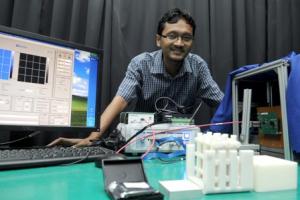Universiti Putra Malaysia researcher to upgrade gamma cameras for 3D diagnosis

Associate Professor Dr M. Iqbal Saripan Copyright : Photo by Noor Azreen Awangtra Malaysia
The difference of this prototype machine – the size of a large accordion – is that it uses angle-based gamma-ray detection instead of single angle-based detection to show up a tumour or cyst in 3D, so that doctors can zoom in for a sample for a biopsy, the gold standard test for any cancer.
The single-photon emission computed tomography (SPECT) camera device is the work of Associate Professor Iqbal Saripan, 33, head of the Department of Computer and Communication Systems Engineering in the Faculty of Engineering at Universiti Putra Malaysia (UPM). It has taken him more than seven years to reach this stage of his research and passion.
He said it all started when he was accepted for a place under UPM’s tutorship programme after graduating with his B.Eng (Hons) degree in Electrical-Electronics Engineering from Universiti Teknologi Malaysia in Skudai in 2001.
From here, he chose to go to the University of Surrey, United Kingdom, which is well-known for nuclear physics, where he pursued his PhD in medical image processing and completed his thesis on wire mesh collimator for gamma camera for his doctoral degree at age 26.
By then, he had not only gained some real hospital experience but had done a lot of groundwork to see how those multi-million ringgit nuclear imaging devices using 2D gamma-rays can be salvaged by switching to portable gamma-ray for pin-point diagnostic accuracy in 3D.
Like many other developing countries that employ these gamma rays machines, Malaysia has a few such machines for patients, each costing between RM5 million to RM10 million, and they are becoming obsolete.
The poser to the hospitals and government then is whether to replace these machines to those using the latest but expensive nuclear imaging devices or to put new changes to these gamma-rays cameras. The modification can be done by replacing their collimators to improve the performance of the current gamma rays.
In comparison, Dr Iqbal said that typical X-ray machines do not use such high blast of energy as gamma-ray and they cannot “see” through bones, like gamma rays.
But gamma rays can only pinpoint a tumour, or abnormal growth in the body, provided the body is injected with a weak and time-lapse radio isotope and the means where the gamma rays can be concentrated to produce the “image”.
This is where Dr Iqbal came up with his wire mesh collimator, a device that can improve the detection of gamma rays.
It took him years of research work and on-site studies and discussions with manufacturers, like Toshiba and Siemens, and medical doctors before he found the answers.
In the process, he filed one patent on the wire mesh collimators and was awarded a few national and international awards to his name.
He was given the Young Scientist award by Datuk Dr Ewon Ebin, the Minister of Science, Technology and Innovation, in November 2013, while the Academy of Sciences Malaysia recognised him a month later (in December) as one of the top Research Scientists in the country.
Dr Iqbal said he has received some foreign enquiries about his patents and is presently working on patenting another one of his work.
“I would say that 80 to 90 percent of my research work and publications are on nuclear imaging devices,” he said.
Right now, he and his team are ready to put together his prototype portable gamma-ray or SPECT camera for breast cancer detection.
The testing will be done at a hot lab facility in the country.
With inputs from his team of researchers, the portable SPECT camera can be used for young ladies and lactating mothers. “The camera can be used for breast of any volume,” he said with a grin.
By Kuah Guan Oo
For more information, please contact:
Associate Professor Dr M. Iqbal Saripan
Tel: 603 8946 6446/4344
Email: iqbal@upm.edu.my
Iqbal.saripan@gmail.com
Associated links
Media Contact
All latest news from the category: Medical Engineering
The development of medical equipment, products and technical procedures is characterized by high research and development costs in a variety of fields related to the study of human medicine.
innovations-report provides informative and stimulating reports and articles on topics ranging from imaging processes, cell and tissue techniques, optical techniques, implants, orthopedic aids, clinical and medical office equipment, dialysis systems and x-ray/radiation monitoring devices to endoscopy, ultrasound, surgical techniques, and dental materials.
Newest articles

A universal framework for spatial biology
SpatialData is a freely accessible tool to unify and integrate data from different omics technologies accounting for spatial information, which can provide holistic insights into health and disease. Biological processes…

How complex biological processes arise
A $20 million grant from the U.S. National Science Foundation (NSF) will support the establishment and operation of the National Synthesis Center for Emergence in the Molecular and Cellular Sciences (NCEMS) at…

Airborne single-photon lidar system achieves high-resolution 3D imaging
Compact, low-power system opens doors for photon-efficient drone and satellite-based environmental monitoring and mapping. Researchers have developed a compact and lightweight single-photon airborne lidar system that can acquire high-resolution 3D…





















